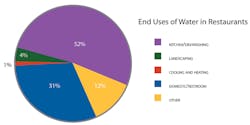Help Customers Put WaterSense to Work in Commercial Kitchens
Commercial and institutional facilities such as schools, hotels, hospitals, and restaurants account for up to 17% of the water provided by our nation’s public suppliers. According to the US Department of Energy, heating water accounts for nearly 7% of the energy costs in commercial buildings. Managers of these operations can significantly reduce their water use, save energy, and lower operating costs by understanding how water is used in their facilities and ways to use it more efficiently.
But where do they start?
EPA’s WaterSense program recently created WaterSense at Work: Best Management Practices for Commercial and Institutional Facilities, a compendium of best water management practices and case studies about saving water in commercial settings. Through this online resource, utilities can find a wealth of information to share with commercial and institutional customers in many different sectors and facility types.
Cooking, Cleaning, and Saving
For utilities looking to launch or revive a commercial and institutional water conservation program, the kitchen is one of the best places to start. Hospitality and food service establishments account for approximately 15% of the total water used in the commercial and instituti
- Equipment such as wok stoves, or dipper wells like the ones found in ice cream shops, use a continuous flow of water that can be reduced or turned off when not in use.
- Cooking equipment that relies on a boiler–steam kettles, steam cookers, or combination ovens, for example–can use a great deal of water. Proper operation and maintenance can help reduce water use, and water efficient replacement options are available.
- Pre-rinse spray valves, the devices used to remove food and debris from dishes before commercial dishwashing, come in water efficient, energy-saving models (see sidebar below- “Save It, Don’t Spray It”). Periodic inspection and cleaning of prerinse spray valves with products that dissolve scale buildup can also help the valves use water more efficiently.
- Conventional garbage disposal systems, which can use up to 15 gallons of water per minute (gpm), can be retrofitted with a load sensor to reduce water use to 1.0 gpm.
Darden Restaurants, one of the largest restaurant groups in the country with brands such as Red Lobster and Olive Garden, was recently recognized by the Alliance for Water Efficiency and the American Council for an Energy-Efficient Economy for its water and energy conservation achievements ( http://bit.ly/VZ4OEf). The company reduced its total water use by 7.8% between 2008 and 2011, for a cumulative of one billion gallons of water saved. On average, Darden Restaurants have decreased water use by 17% per facility by installing water efficient kitchen fixtures, removing dipper wells, using faucet aerators, and incorporating other water-saving ideas provided by its employee-led Green Teams.
EPA has also profiled three restaurants certified by the Green Restaurant Association: Uncommon Grounds in Chicago, Founding Farmers in Washington, DC, and The Grey Plume in Omaha, Nebraska ( http://1.usa.gov/10WSMAe). Each has saved significant amounts of water using many of the best management practices outlined in WaterSense at Work.
Awash in Efficiency
As part of its efforts to help commercial kitchens save energy, ENERGY STAR labels dishwashers, ice machines, and steam cookers and provides advice and tips for restaurants (http://1.usa.gov/gryyvE). ENERGY STAR–qualified commercial dishwashers use 40% less energy and water on average compared to conventional models. They can save a business an average of $3,000 per year on its energy and water bills and an average of 63,000 gallons of water per year, depending on the product type. Educating dishwashing staff on proper preparation and loading techniques can also save water used for washing dishes.
By replacing tank-type toilets, flushing urinals, faucets, and other fixtures with WaterSense-labeled models, restaurants can save water in their restrooms, which account for about 30% of water use in food service establishments. WaterSense-labeled flushing urinals, for example, use no more than 0.5 gallons per flush, at least 50% less water than standard models. Models bearing the WaterSense label have been independently certified to meet EPA’s strict criteria for both water savings and product performance.
Encouraging restaurants to routinely check faucets and other fixtures for leaks also helps ensure they aren’t sending water and money down the drain. And if the facility has already invested in automatic sensors on bathroom fixtures, it’s important to ensure they are operating properly and avoid unnecessary water use.
A Good Tip for Going Green
These are just a few of the dozens of different best management practices WaterSense has compiled to help utilities promote water efficiency everywhere from cafeterias to cruise ships. Each chapter in WaterSense at Work provides operation and maintenance advice, retrofit/replacement options, and equations to calculate savings and payback.
With the growing emphasis on organic cuisine, farm-to-table food, and other aspects of the “green” restaurant movement, saving water in the kitchen and beyond is a good business model for forward-thinking food service establishments. WaterSense has created a simple fact sheet on saving water in restaurants that can be easily downloaded and shared to make the business case for keeping water efficiency on the menu.
Visit the WaterSense website at http://www.epa.gov/watersense/commercial to download the “Saving Water in Restaurants” factsheet, access WaterSense at Work, or learn more ways to help commercial and institutional customers use water efficiently.



